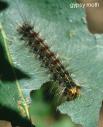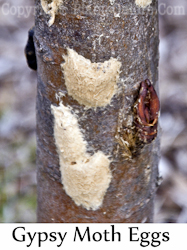|
Gypsy
moths are not native to America. That is one of the reasons
that they are such a pest. They have no long-term relationship
with predator species as do our native insects. There are
several predator wasps which do attack the egg masses and
these have been on the increase lately. However, as with most
predator/prey interactions, the predator populations lag
behind that of the prey. You have to have a lot of gypsy moth
caterpillars for them to feed on before you get enough wasps
to help control the pest.
 The real
control of gypsy moth caterpillars seems to come from a
naturally occurring virus that the insect carries with it.
Unfortunately, this virus does not do its dirty work until the
caterpillars are stressed from having eaten all their food
supply. Generally, after two or three years of heavy
infestation, there are so many caterpillars that they start to
get hungry. This is when the virus kicks in and begins to kill
off large numbers of the pest. Then, populations crash and the
problem goes away for a few years until the caterpillars build
up again. The real
control of gypsy moth caterpillars seems to come from a
naturally occurring virus that the insect carries with it.
Unfortunately, this virus does not do its dirty work until the
caterpillars are stressed from having eaten all their food
supply. Generally, after two or three years of heavy
infestation, there are so many caterpillars that they start to
get hungry. This is when the virus kicks in and begins to kill
off large numbers of the pest. Then, populations crash and the
problem goes away for a few years until the caterpillars build
up again.
Another factor that may influence the level
of the problem this year is the impact of the cold
temperatures from last January and February. It is known that
temperatures below minus twenty degrees Fahrenheit will kill
large numbers of eggs. A temperature of minus ten will kill
some of the eggs. Although we did not reach the minus twenty
level, there were several nights with temperatures in the
minus ten to fifteen range. Only time will tell if this had
any significant impact.
Gypsy moth caterpillars begin to hatch in
early to mid-May and start eating on the leaves at the top of
the trees. Oaks,
poplars, crabapples,
willows, birches and
red leaf cultivars of Norway maple are their favorites. If
populations get high, they may also munch on other trees too.
 The caterpillars continue to feed and grow
larger until late June or early July. Then, they stop feeding,
pupate and become adult moths. The female moth is whitish in
color and cannot fly. She lays eggs for next year's brood
somewhere near where she emerges from her pupal case. The caterpillars continue to feed and grow
larger until late June or early July. Then, they stop feeding,
pupate and become adult moths. The female moth is whitish in
color and cannot fly. She lays eggs for next year's brood
somewhere near where she emerges from her pupal case.
Remember, gypsy moth caterpillars DO NOT
form web nests like the Eastern tent caterpillar or the fall
webworm. They are extremely hairy caterpillars with five pairs
of blue dots and six pairs of red dots along the back. This
pest is only actively eating in the trees for about 6 weeks
between May to early July. Most of the damage occurs in mid to
late June when the caterpillars are at their largest size.
In heavily wooded areas, aerial spraying with the
biological agent Bt (Bacillus thuringiensis) are
used to minimize the damage. However, this is not practical in
more urban areas or to protect a few trees in a back yard.
Fortunately, there are some options available to protect
individual trees in the backyard.
 Winter is a good time to inspect trees,
buildings and lawn furniture for gypsy moth egg masses. The
eggs are laid in a "velvety" mass about the size of a half
dollar. Scrape them off into a container of soapy water or
otherwise destroy them. Do not just drop them to the ground. Winter is a good time to inspect trees,
buildings and lawn furniture for gypsy moth egg masses. The
eggs are laid in a "velvety" mass about the size of a half
dollar. Scrape them off into a container of soapy water or
otherwise destroy them. Do not just drop them to the ground.
Small caterpillars feed on trees during the
daytime. As they get bigger, they begin to move down the tree
to hide during the day and go back up to feed in the evening.
Homeowners can take advantage of this daily migration to
eliminate some of the caterpillars.
 Several techniques may be employed. Using
burlap and string or twine, construct a "hiding" place for the
caterpillars. Burlap should be 12 to 18 inches wide and long
enough to wrap completely around the tree about chest height.
Tie it to the tree with the twine and fold the upper portion
down to form a flap or "skirt" around the trunk. Several techniques may be employed. Using
burlap and string or twine, construct a "hiding" place for the
caterpillars. Burlap should be 12 to 18 inches wide and long
enough to wrap completely around the tree about chest height.
Tie it to the tree with the twine and fold the upper portion
down to form a flap or "skirt" around the trunk.
During the morning hours, caterpillars will
collect under the flap. In the afternoon, lift the flap and
sweep the critters into a bucket of soapy water. Use a small
brush, broom or rubber gloves to move the caterpillars. Some
people experience an allergic reaction from touching the
"hairs" of the caterpillars.
Another alternative is to place a piece of
slippery tape around the tree. This allows the caterpillars to
go down the tree but, when they try to go back up, they cannot
cross the slippery area. Sticky bands may also be used to snag
the caterpillars as they move down the trunk. Buy a
commercially prepared tree wrap or put a several inch wide
band of a non-porous tape around the tree. Place tanglefoot on
the tape in order to catch the insects as they crawl down the
tree.
NEVER, NEVER, NEVER put the tanglefoot or
grease, tar or creosote DIRECTLY onto the bark. This will
leave a permanent stain and may severely damage younger trees.
 Small trees may be protected with sprays
using a low volume sprayer. Bt sold as Dipel, Thuricide or
Bactur is a biologically safe spray. This bacteria only
affects the caterpillars and will not kill other insects,
birds or mammals. Spray it on the leaves and allow the insects
to eat them. They will quickly stop eating, develop a gut
infection and die. Small trees may be protected with sprays
using a low volume sprayer. Bt sold as Dipel, Thuricide or
Bactur is a biologically safe spray. This bacteria only
affects the caterpillars and will not kill other insects,
birds or mammals. Spray it on the leaves and allow the insects
to eat them. They will quickly stop eating, develop a gut
infection and die.
Unfortunately, Bt must be used when the
caterpillars are small (less than 1 inch) to be effective. It
will not work on large caterpillars.
Chemical
insecticides labeled for gypsy moth control may also be
used. These insecticides are non-selective and will also kill
honeybees and beneficial insects such as parasitic wasps that
feed on the gypsy moth. So, take care when using them and be
sure to follow the label directions, avoid windy days and use
these sprays sparingly.
For small numbers of trees, a systemic
implant called Ace Caps may also work. Holes must be drilled
into the base of the tree and the capsules are implanted to
release their chemicals directly into the trees vascular
system. If not done properly, this may cause damage to the
tree and may also result in uneven distribution of the
chemical throughout the canopy of the tree. Generally, these
caps are applied by a professional applicator.
In larger wooded areas, neighbors may need
to group together and hire an aerial sprayer to cover the
area. Check with the spray company for details but they
usually need an area of at least 10 to 15 acres in size to
make this option viable.
Experience in parts of the country which
have had severe infestations for years indicates that an
otherwise healthy tree can survive total defoliation for 2 or
3 years in a row. Trees that are already under stress from old
age, disease or poor site conditions will be further stressed.
In some cases, this could push them over the edge.
In the end, the best defense will be to keep
the trees otherwise healthy by proper watering, fertilizing
and pruning. Banding techniques can help to minimize damage in
severe infestations. Insecticide applications may help but,
due to the size of many infested trees, it is expensive and
difficult.
|



